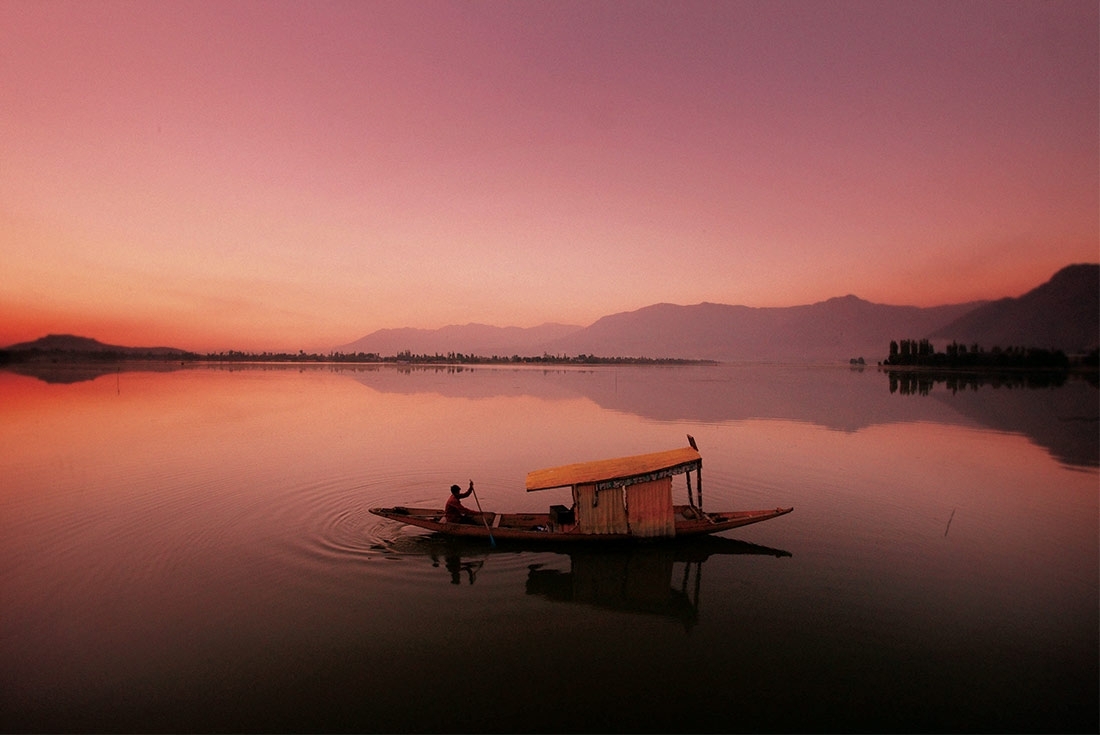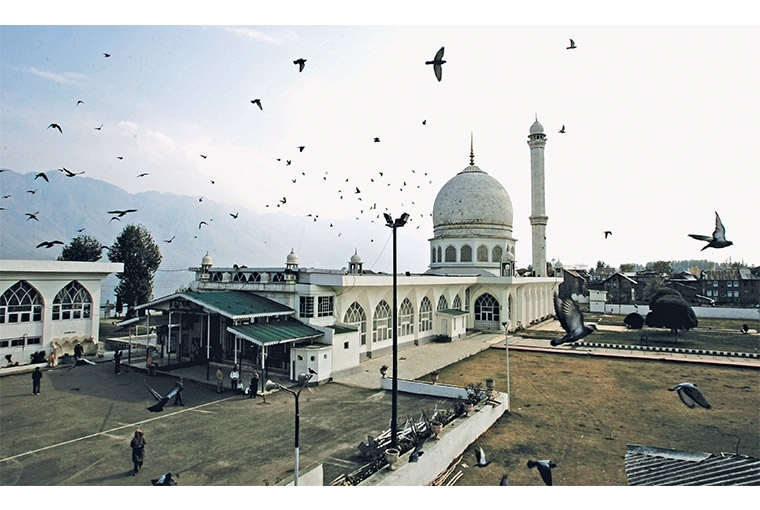
Photo Courtesy: The Lalit

Photo Courtesy: The Lalit
Hameen ast. It is here...
If I could begin with the end of how it felt to leave Kashmir, it was as if someone was taking me away from the only place worth being. But we can’t begin with ends, we cannot end with beginnings. And so I must start with my descent into heaven instead of the proverbial ascent—you may rise Biblically, but it is only when you come down to an earth mired in many a conflict that you actually appreciate the heaven that still throbs at its heart.
One sunny morning, the streets of Srinagar took me into the palatial arms of The Lalit. Via eerie silences, gun-lined roads, brave uniforms, pherans pulled straight out of Arabian fairytales...an air of a mixed, silenced beauty now so doubtful of itself—the kind where fear befriends fantasy, the same kind of vulnerability that makes a woman ever so beautiful. Srinagar began with this silence, and later, as you’d know, concluded with a silence where so much still remained.
From airport to city was a time of sheer wonder toward what this world is, what it would be like in a few days from now; the first moments in any city the strangest as its spirit greets yours. Everything may have appeared ordinary— shop signboards and shutters, school-ready children, girls in hijab, old men on bicycles, carpet cellars, sloping houses from another time in history, a stray sheep here and there— except that it wasn’t. Each feature, each corner shone with a resplendent resilience, each child’s smile so strong and each of those houses hardened with the courage to come out of the devastating 2014 floods that submerged the low-lying part of the city we were driving through. The main street—all green, all guarded; the bridge over the Jhelum, a river that takes you on a ferry from Old Srinagar to the new through sunsets, many histories and buzzing city life, the hills above the horizon pulsating with border stories—how could any of that possibly be ordinary!
A little later, we arrived at the gates of The Lalit Grand Palace Srinagar, the former residence of the Maharaja of Jammu & Kashmir from the Dogra dynasty. After Maharaja Hari Singh moved to Mumbai post Independence, the palace saw many restorations and stands at its grandest today. The gates of the fortress are a mile from its reception, and the joy of seeing fresh apple-laden trees on either side is too great to contain at breakfast time. I do not know what kind of enthusiastic guest would not ask to pull over, pluck a few of those gorgeous reds and bite into the juice while still walking the grove and not settling in! But those apples, which lasted almost the whole time of my stay, were a reminder of the greatest pleasures of nature experienced firsthand—also a tiny summation of the rest of Kashmir, best tasted in a sheer element. The organic odyssey would continue later with fresh mountain trout and gul niloufer [lotuses] plucked from the Dal, but I will take you there a little later.
Enter the palace. The Lalit has a grand foyer with unparalleled historical grandeur. Its intricate ceiling carvings, tell- ing stories from ancient scriptures, remain immaculate even after so many years. The reception is flanked by the suites to the left and the restaurants and banquet to the right. There are 113 palace rooms and suites, including 10 cottages, and over 4,000 square feet of gardens. Outside, each of those Chinar trees, strong and majestic, are poetry. Tons of their yellow leaves have been flown to Bombay studios for film romance, heads of many a state have pictures under their shade, and as I cool off my heels on the soft grass underneath those thick branches, I seem to find my faith again in the timelessness of some good things. The kehwa on welcome— an infusion of green tea with saffron, cinnamon, cardamom, roses, and nuts—seems perfect to warm the day as does the staff, my first introduction to the famed Kashmiri hospitality.
The suite opens out to Dal Lake in the distance, but there are so many flowers like rows of soldiers protecting its beauty—it isn’t easy to get a view. All around are mighty mountains—a halo of the Himalaya so quiet it’s difficult to imagine the battles it’s fighting. But those seem nowhere close in this private paradise. You’re floating in a bed of marigolds and majestic golds. A chirpy staff member called Nazeera comes smiling and with childlike enthusiasm takes you along into the deepest corners of the property—there is a secret tunnel that the Royals used, now converted into a swanky underground club. There is the Maharaja’s Suite frequented by celebrities and state heads, but it is the Chinar Garden sit-out that wins the heart with its sun-and-shade, great hospitality, views of the valley and the Dal. There, we meet Head Chef Mondol, who decides on a lunch of fresh mountain trout with a Bengali fusion for us before we set out.
THE DAL & ROTI
That evening, we float the Dal. You may imagine it as painted scenery, extremely touristy, too perfect perhaps to enjoy as your own. But the reality of it is even more endearing—haggling with shikara rowers, the bright desi yellows reds greens, the wobbly descent into the umbrella boat and dealing with the seasoned sellers who try to strike up ‘sister’ conversations. The sunset is around the horizon, the blue mountains rise in waves of wonder, all the aazans about town converge into that stillness... Suddenly, a paper mache seller pulls up to break the reverie. Not interested? There’s silver jewelry, sister, oh and vegetables, fruits and spices along lake corners even! The Dal, through an hour-long ride that appears nothing less than carpeting through the clouds, is lined with a bunch of houseboats in offseason, colonies of lotus, local houses, a wrecked boat shack or two, markets. The waters have a life of their own, birds dive and fish jump, now green now blue, still in the centre of chaos. I do not know how that hour passes; the Dal is a peace strong enough to drown the greatest unrest inside and out.
Back for dinner, I find dearly prepared Kashmiri Wazwan waiting in the royal corner of the Chinar Garden, under the legendary Gandhi Chinab tree. In the Kashmiri language, waz means ‘cook’ or ‘cooking’ and wan means ‘shop’. The ulti- mate formal banquet in Kashmir is the royal wazwan, which is now laid out in front of me. Traditionally it has 36 courses, but I can barely manage about seven, which are served in the traditional Trami or shared plate from which the guests and the family eats. Thankfully there’s a friend to share the meal with. The Rista [meatballs in a fiery red gravy], Gushtaba [meatballs mellowed with yogurt] and Tabak Maas [ribs of lamb simmered in yogurt then fried] and Dum Aloo are some of the main dishes that I still haven’t gotten over. The pastel pink Noon Chai is an endearing digestive as are the ferments of the many pieces of bread or rotis—shirmal, bakirkhani, ghyev czhot. The bright moon above is an apt lamp for the setting and the spread leaves you almost dazed; The Lalit spoils us with the best. You wonder if Coleridge had anything to do with Kashmir when he wrote, She sent the gentle sleep from Heaven, that slid into my soul.
SONMARG
The next day, sunny and bright, we take off to Sonmarg, feasting on fresh mountain air and taking in the water from the streams. The roads are uneven in places, cut out from rough mountains, but the journey is softened by beds of green as far as the sight goes. The countryside greets your soul with herds of sheep and miles of undisturbed natural beauty, you wonder about the enormity of this enchantment. An Army convoy whizzes by, everything is part of the landscape, there is a harmony to these extremes that make the fabric of this place so fascinating.
We arrive. Sonmarg means Meadow of Gold. To me it means the idyll of what I see before me—a horse grazes the fields, in the distance the gleaming snow-capped peaks— Kolhoi, Machoi, Amarnath—beckon you to the beyond, but it is a flock of young schoolgirls that define it the best. They come smiling, asking about you and the world they are yet to see, giggling with innocence, reciting a poem on love and pushing back their headscarves just a little so that their snow-like beaming faces are visible enough for our selfie. In them, Sonmarg shines with a soul of gold.

A usual mid-day scene
Photo: Showkat Shafi
GULMARG, DOWNTOWN, SALUTES
To have heard of its wonder is one thing; to listen to its winds is another. Gulmarg, an endless meadow more brilliant than some of the best Swiss countryside, is best walked on foot and flown across by cable. The drizzle and winds made the latter unfeasible for us, but a freewheeling walk and some good hot chocolate among the daisies was just as refreshing. Gulmarg, situated in the Baramulla district, literally means Meadow of Flowers, and when it is not capped by snow, it is crowned by some of the loveliest wildflowers such as buttercups, tulips, forget-me-nots, a brook there a bridge here, and dotted with lines of cottages which call for another chapter of country travel unto itself.
Gulmarg is a day-trip away, and we return to Srinagar to explore some of the everyday city. We drive by the Nigeen Lake that is the new hipster Dal, small and sweet; we see the buzzing market at Lal Chowk and go down one of the oldest carpet cellars to see a young weaver put to practice an age-old Arabic design note. Thereafter, we take the street Downtown. Downtown is where the arms and uniforms are always braced for riot, where the sentiment is throbbing with resentment, where I see a crashed windshield covered with a floral Persian carpet. Roses greater than guns. We drive by narrow lanes of houses once occupied by Kashmiri Pundits, wall slogans provocative and powerful, and arrive beyond the bustle into the shelter of the Hazratbal Shrine, its dome of divinity rising above everything else. Inside, we are offered Kehwa from a family celebration for a new child, and the holy rice in the prayer area for women. Qismet, smiles our very patient driver, Lateef. We leave upon [tying] a string and a prayer.
We are also fortunate that evening to get a glimpse of the Army War Memorial, a solemn place of strength and sacrifice that inspires the deepest respect for our men of guard. One of the inscriptions is a line by John Maxwell Edmonds: When you go home, tell them of us and say, for your tomorrow, we gave our today. With the names of the martyrs and blank spaces yet to be filled, the Memorial humbles you, and lest your spirits sink, a crescent moon rises as do the sounds of the evening aarti and the aazan all at once, an invocation yet again of the harmony that pervades this place of many political, natural, spiritual and humanitarian shades. A place that absorbs conflict, emanates peace. Eats the dark and glows with light. A place that turns the loss of life into a profusion of pure soul for parched visitors. Isn’t that what Paradise is? Hameen ast.
Text Soumya Mukerji

Hazratbal Shrine
Photo: Showkat Shafi